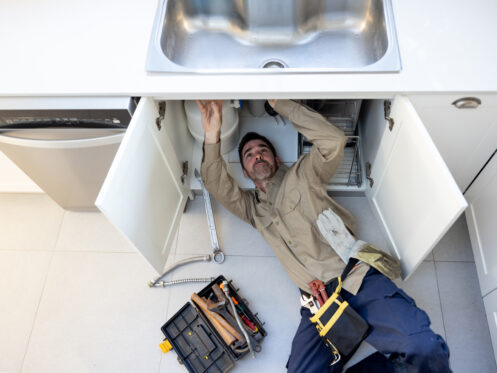When pipes become damaged or compromised, prompt and skilled repair is essential. A licensed plumber can apply appropriate solutions to prevent further issues such as leaks, water damage and potential health hazards. If you’ve scheduled a pipe repair, here’s what you can expect to take place.
1. Initial Assessment
During the initial assessment phase, professionals inspect the damaged pipe thoroughly. They determine the extent of the damage, whether it’s due to corrosion, cracks or other issues. Plumbers use a variety of tools and equipment to assess the severity of a pipe repair, including moisture meters, thermal imaging cameras and acoustic leak detection devices. These tools help plumbers accurately locate leaks hidden behind walls or underground. This is paramount to determining the extent of the damage.
2. Planning and Preparation
Once the assessment is complete, professionals develop a detailed repair plan. This plan includes selecting the appropriate repair method and gathering the necessary tools and materials. Careful planning ensures that the repair process is efficient and effective, minimizing downtime and disruptions.
Some of the tools that they may plan to use for the repair include:
- pipe cutters
- wrenches
- soldering equipment for soldering joints
- pipe wrenches for tightening fittings
- specialized equipment for pipe lining or trenchless repairs
3. Site Preparation
Before beginning the repair work, professionals clear the work area of any obstructions or hazards. They also ensure that safety measures are in place to protect themselves and others. Site preparation is essential for creating a conducive environment for the repair work to proceed safely and smoothly.
4. Pipe Repair Techniques
Plumbers have a variety of solutions to choose from for fixing damaged pipes, including epoxy lining and pipe bursting. Epoxy lining involves coating the interior of the pipe with epoxy resin, creating a new protective layer to seal leaks and reinforce the pipe’s structure. Pipe bursting involves breaking the existing pipe and pulling a new one through in its place. The choice between these techniques depends on factors such as the extent of damage, pipe material and accessibility for repair.
5. Repair Execution
During the repair execution phase, professionals follow a step-by-step process to repair the damaged pipe. This may involve cutting out the damaged section, welding or bonding new pipe segments and ensuring proper alignment and sealing. Precision and accuracy are paramount to achieving a successful repair.
6. Quality Control
After completing the repair, plumbers meticulously inspect the repaired pipe. They conduct pressure tests and flow checks to verify proper functionality and detect any potential leaks or issues. Final inspections are crucial to guaranteeing the effectiveness of the repair and the long-term integrity of the plumbing system. Identifying and addressing any lingering problems during this stage ensures that the repair meets safety standards. It also provides lasting results, offering peace of mind to both the plumber and the property owner.
7. Cleanup and Restoration
Plumbers meticulously clean the work area, eliminating any excess materials or debris caused by the repair process. They restore the work area to its original condition, ensuring a seamless transition back to its initial state. This step is crucial to minimizing inconveniences for the homeowner and other people living in the home.
How Long Does a Pipe Repair Take?
The duration of a pipe repair varies depending on several factors, including the extent of the damage, the type of repair needed and the accessibility of the pipe. Minor repairs, such as patching small leaks, generally take a few hours. More extensive repairs, such as replacing a section of damaged pipe or addressing multiple leaks, may take longer, potentially spanning several hours to a full day. It’s best to consult with the plumbing professional for a more accurate estimate based on the specific circumstances.
How Much Does a Pipe Repair Cost?
Damage severity, repair type, and materials all have a role in determining how much it will cost to fix a pipe. Minor repairs, such as correcting tiny leaks, may not cost too much, but major repairs or replacements can become pricey. For precise pricing that takes your unique circumstances into account, it’s wise to get quotes from licensed plumbers.
Next Level Plumbing helps Sarasota, FL, homeowners with water heater installations, sewer line repairs, drain cleaning and much more. To schedule a pipe repair for your home, call us now.


